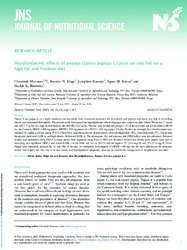Hypolipidaemic effects of papaya (Carica papaya L.) juice on rats fed on a high fat and fructose diet.
Date
2023-07-10Author
Matsuane, Christinah
Kiage, Beatrice N.
Karanja, Josephine
Kavoo, Agnes M
Rimberia, Fredah K.
Metadata
Show full item recordAbstract
Papaya (Carica papaya L.) is a highly nutritious and less-caloric fruit, commonly consumed for its minerals and vitamins and hence may help in controlling obesity and abdominal discomforts. The present study investigated the hypolipidaemic effects of papaya juice extract on male Albino Wistar rats (7 weeks old; 185 ± 17 g) fed on a high fat and fructose diet (HFFD) for 6 weeks. The rats were divided into groups I-IV of five rats each and fed on either a HFFD (i.e. the Control), HFFD + 200 mg papaya, HFFD + 350 mg papaya or a HFFD + 500 mg papaya. On day 34, after an overnight fast, blood samples were obtained by cardiac puncture under 99⋅8 % Chloroform anaesthesia for the determination of serum triglyceride (TG), total cholesterol (TC), low-density lipoprotein cholesterol (LDL-c) and high-density cholesterol (HDL-c). The atherogenic (AI) and coronary risk (CRI) indices were also calculated. Statistical analysis was performed using ANOVA where means were separated using Tukey's HSD test. Resulted showed that all rats given papaya juice had an increasing, non-significant HDL-c and reduced LDL-c levels while rats fed on HFFD had the highest TC (53⋅2 mg/dl) and TG (37⋅6 mg/dl) levels. Papaya juice statistically reduced the AI and CRI of the rats. In conclusion, consumption of HFFD + 500 mg was the most effective in the reduction of rats' blood lipids and fats, due to its anti-obesity and hypolipidaemic properties, thus can be used in the management of dyspilidaemic disorders.
URI
10.1017/jns.2023.61http://journals.cambridge.org/action/displayJournal?jid=JNS
https://doaj.org/toc/2048-6790
https://hdl.handle.net/13049/710
Collections
- Reseach articles [146]

